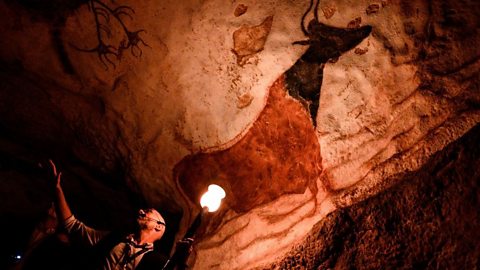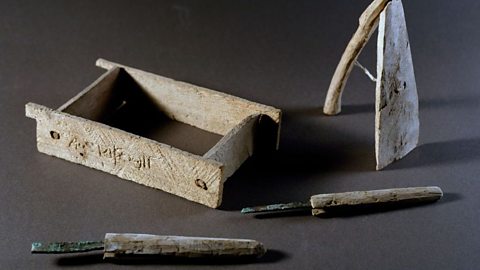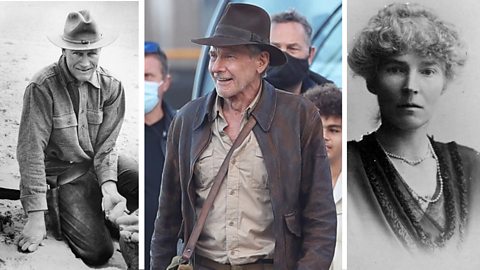When you’re an archaeologist you don’t know what you’re going to find until it’s right there in front of you.
Will your next dig uncover secrets from the past that will change everything we’ve assumed about people living 1,000 years ago? Or will it come up empty?
When you ask an archaeologist what they think is still out there to be discovered, they may be reluctant to answer at first. But probe a little deeper, and they’ll often admit that they’re guarding a wish list of objects they would be delighted to unearth.
Â鶹ԼĹÄ Bitesize put the question to two archaeologists, and their answers promise to challenge many of our assumptions about the past - if only those fascinating discoveries can be made.
Prehistoric cave art
Jill Cook, keeper of the department of Britain, Europe & Prehistory at the British Museum, says new technology and improved lighting could lead to the discovery of more drawings or paintings on cave walls.

Ancient art work gives us clues about how cave dwellers thought. Pictures of a pig and human-like figures were discovered on the Indonesian island of Sulawesi in July 2024, which revealed that people living at least 51,200 years ago could think creatively and tell stories. Jill says advances in technology like 3D modelling and scientific dating also help experts find out more about cave paintings.
She said: “In the 1990s when we first began to see what was underground in the Chauvet Cave in France it was a revelation because we were able to see that it was older than we expected. Looking at those with 3D modelling you can actually distinguish the work of different artists.
“It would be great to find something in this country. It probably won't be paintings, it’s more likely to be engravings.”
Wooden tools
Historians know a lot about tools and weapons made from stone, such as scrapers, choppers and arrows, because they remain well-preserved even thousands of years after they were used. Objects made from bronze and gold do not rust, and, while ancient iron items are usually corroded, it’s still possible to work out how they are likely to have been used.

But what about materials that have vanished without a trace? Prof Larry Barham, of the University of Liverpool’s Archaeology, Classics and Egyptology department, is particularly excited about the chance of finding tools made of wood. He says there is a huge gap in what we know about how ancient humans lived because their wooden objects have long since rotted away.
There could be some wooden tools still out there, however - in waterlogged areas where the bacteria that causes rot is unable to function. These finds would be important because the ways ancient humans used tools tells us how advanced their language was. The more complex the tool, the more they would need words to show others how to use it. And if a tool needed two people to operate it, they might have needed words rather than gestures to work together.
Looking for quizzes, amazing stories and fun facts?
Bitesize Topical has it all!

Bog bodies
It’s not only wood that can be discovered preserved in water - bodies buried in waterlogged ground have been found naturally mummified, sometimes with their skin and even internal organs still partially intact.

They include Lindow Man, whose Iron Age remains were discovered in Cheshire in 1984 and are now on permanent display at the British Museum.
Jill said: “Remains in waterlogged deposits are always very exciting but there’s a real worry at the moment because as our climate changes a lot of wet deposits are drying out. And once they start to dry out the things they contain rot away. So getting to those sites, which preserve all kinds of extraordinary stories of things, is very important.”
Villages and homesteads
The government’s 2024 plan to make it easier to get planning permission for houses could speed up some archaeological discoveries, says Jill. Currently, some developments have been paused because they are on land that could contain traces of the past.
She said: “If planning now starts to go ahead more rapidly, those sites will have to be investigated and who knows what we will find. There may well be villages, homesteads awaiting investigation under those sites.”

Prof Barham is also keen to find a village - in a location where he found the world’s oldest structure in 2019. His discovery in Kalambo Falls, Zambia, dates back at least 476,000 years - to before the evolution of our own species, Homo sapiens - and shows people were able to use intelligence and imagination to deliberately fit logs together into a structure. The discovery also suggests that early people were also invested in staying in one place for a long time, rather than being constantly on then move.
He said: “We might find a village with houses made of wood. Nobody would imagine that could happen, but now with that structure they’re making - I’m thinking why not?
“I would like to see their domestic arrangements, see where they did the cooking, possibly where they slept. I would like a glimpse of daily life from that time.”
Plague pathogens
Thanks to modern technology, archaeologists these days are like forensic crime scene investigators, said Jill.
She explained that innovations such as fingerprinting and DNA - which we might usually associate with police work - also have their place in archaeology: “Now we look at sites for all the bits of information from all sorts of scientific spheres, to build up into pictures of what was actually going on at the site.
“Even with burials, we can find the DNA of pathogens that cause plague. It's not infectious. You can pick up traces of it and suddenly you can see why at a particular period you seem to have a decrease in settlements. It's because something has ravaged the country.”
This article was published in August 2024
Indiana Jones: Meet four of history’s archaeological adventurers
The men and women who unearthed history over the decades

Three incredible ancient ruins that you might not have heard of
Petra, Pompeii and Machu Picchu might grab the headlines, but join Â鶹ԼĹÄ Bitesize as we explore the amazing ruins of Hegra, Herculaneum and Ollantaytambo.

Three huge betrayals that made history
Â鶹ԼĹÄ Bitesize delves into the stories of three historical figures who betrayed their countries or political leaders.
